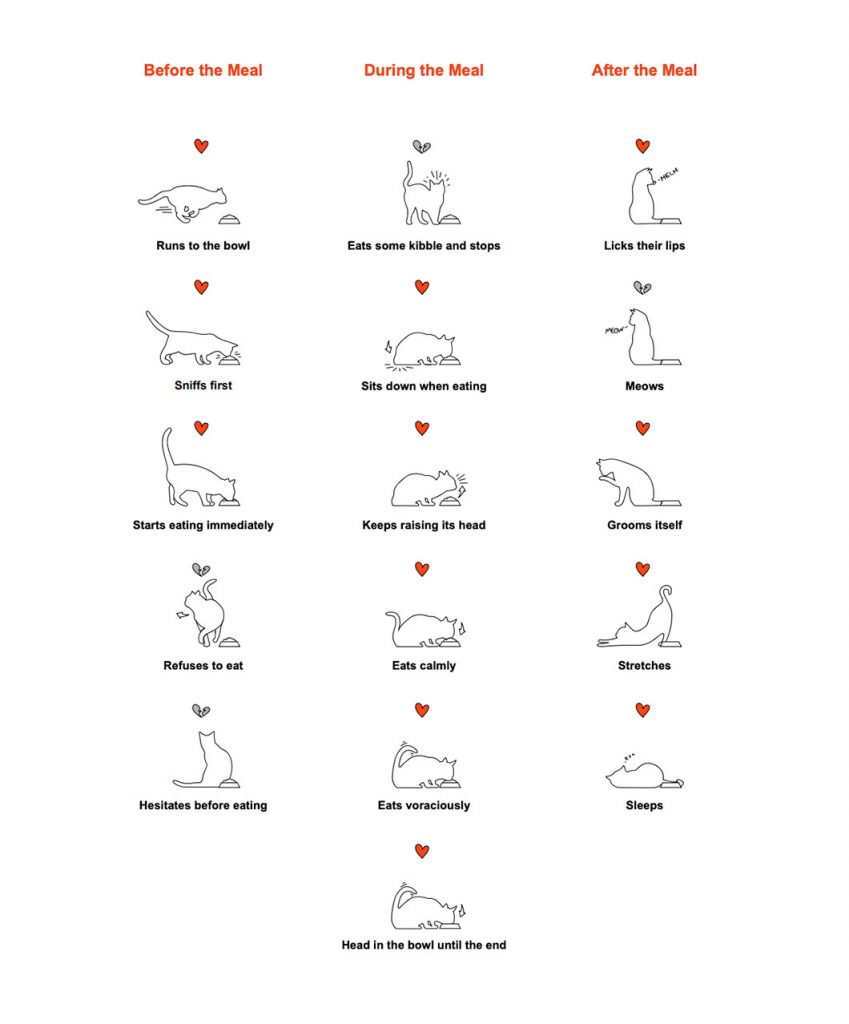Taken from our study on the Cat Food Decision Making Journey
Owners judge a food’s success not just on whether the cat eats it but whether they visibly enjoy it. They want to see clear signs that their cats are appreciating the food, much like themselves when they eat a good meal.
A cat’s body language and their behavior at the bowl can strongly influence their owner’s perception of whether their choice is a good one. French pet food company Panelis studied bowl behaviors to understand how people perceived their pet’s reaction to a food.

The study found 16 consistent behaviors across the entire feeding ritual (before, during, and after eating) and each was assigned a positive or negative value, indicating whether the cat was enjoying the food and whether the choice was a success or not.
These interpreted behaviors were analyzed alongside data captured on the amount of food consumed and the consistency of consumption. What they found was that most owners are exceptionally good at interpreting their pet’s behavior and extrapolating it to determine whether they had made a good choice (success) or a bad one (failure).
When the cat refuses the food.
At the Moment of Use, if a cat rejects the food, or even starts eating it but then stops, most owners begin to get a sinking sensation in their stomachs. The initial feelings of hope and anticipation disappear as anxiety, doubt, and eventually, frustration and disappointment take their place.
If this Moment of Use isn’t the first experience of a food refusal and is a continued pattern of behavior by the cat, the feelings of frustration and disappointment can amplify. And in the case of an owner whose cat hasn’t eaten for days, with the situation fast becoming critical, they can quickly escalate to fear, desperation and despair.
People who experience these unsuccessful Moments of Use often feel a sense of failure and are filled with regret. They reflect on their experience as one where time, energy, and money have been wasted and their cat still hasn’t eaten.
What’s interesting is how little or much the brand is considered at this point.
Some take a fatalistic view; believing they have fallen victim to the trial and error cycle that is finding a food their cat will like and despite their best guess, it just didn’t work.
Others turn the blame inwards; believing they made an error in their decision-making process, such as overlooking a key criteria, trusting an unreliable source, or not doing enough homework.
And some turn the blame towards the brand; believing the brand has let them down, has provided them with a poor quality or unsuitable food despite all of its promises.
How people respond in this moment can have a big influence on which brands make it into the secondary consideration set.
This unsuccessful Moment of Use forces the owner back into Active Evaluation. Which phase they enter tends to depend on how much time they spent exploring the category and how big their final consideration set was.
Some people who already have a second choice will reenter the journey in the Shopping phase, already knowing what they’re going to get and focus simply on acquiring it.
Others who may have raced through the initial journey may need to spend more time exploring the category and identifying options.
However, most people, rather than need to revisit the category and journey as a whole, or if their =criteria haven’t changed, will head back into the Evaluation phase to reexamine their options looking for a next-best alternative. We’ve called this shortcut back into Evaluation the Reconsideration Route.
How people view a brand’s involvement in their initial choice will inform whether they default to an alternative within the brand portfolio (brand preference), consider the brand as well as competitors (brand ambivalence) or whether they actively avoid the brand (brand avoidance).
No cat owner wants to re-enter the decision-making journey. Most will have some form of negative emotion ranging from simple frustration to panic-driven despair and all will place higher expectations on their second choice.
One important thing to note is that a food refusal at the Moment of Use can also occur after a period of eating the first choice food; if the cat loses interest in it or develops an aversion to it. The phase of Active Evaluation the owner defaults to and whether the incumbent brand will influence the next choice is likely to be informed by the length of time the cat has eaten the initial food, the length of time of the owner has been out of the decision making journey, and the relationship (type of loyalty) the owner has with the current brand.



